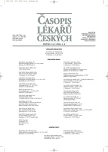WHO Recommendations and Information Encountered by Czech Parents
Výživa kojenců a batolat: Doporučení WHO a informace, se kterými se setkávají čeští rodiče
Východisko.
Značné úsilí bylo s pozoruhodným úspěchem věnováno v posledních 15 letech podpoře a propagaci kojení. Daleko méně pozornosti však bylo donedávna věnováno otázkám výživy dětí v období přechodu z výhradně mléčné stravy na stravu rodinnou. Cílem předložené studie je poskytnout kvalitativní přehled informací o výživě dětí ve věku 6–24 měsíců z různých zdrojů dostupných rodičům a srovnat je s doporučeními WHO založenými na Globální strategii pro výživu kojenců a malých dětí.
Metody a výsledky.
V rámci terénní praxe provedli studenti Univerzity Karlovy, 1. lékařské fakulty interview s 273 matkami dětí do 5 let, řízený rozhovor s 19 dětskými praktickými lékaři, nasbírali 42 propagačních materiálů, identifikovali a vyhodnotili 16 relevantních publikací a 14 webových stránek. Všichni dotazovaní lékaři podávají informace o výživě, doporučují výlučné kojení do 6 měsíců a vhodné zavádění příkrmu, ale pravděpodobně nepodporují dostatečně kojení po 6. měsíci. Rešerše různých zdrojů informací zjistila podle očekávání určité variace v doporučeních o výživě, což je částečně důsledek jejich změn v posledním desetiletí. Většina publikací zdůrazňuje kojení jako ideální výživu do 6. měsíce. Nedostatečně je doporučováno pokračování kojení po 6. měsíci. doporučení o příkrmu jsou až na výjimky společná pro kojené i nekojené děti a i pro ty, které potřebují začít s příkrmem před 6. měsícem. Kromě sporadických zmínek se publikace nezabývají bezpečnou přípravou stravy a krmením v průběhu a po běžné nemoci.
Závěry.
K harmonizaci informací o výživě starších kojenců batolat s doporučeními WHO by přispělo věnovat pozornost všem 10 okruhům vedoucích principů WHO, formulovat jasně doporučení o kojení, rozlišovat informace podle cílové populace a vycházet ze situace prospívajícího dítěte výlučně kojeného do ukončeného 6. měsíce.
Klíčová slova:
příkrm, výživa kojenců, výživa batolat, kojení.
Authors:
E. Kudlová
Authors‘ workplace:
Ústav hygieny a epidemiologie 1. LF UK, Praha
Published in:
Čas. Lék. čes. 2005; 144: 540-544
Category:
Original Article
Overview
Background.
During the last 15 years much effort with remarkable success has been devoted to the promotion and support of breast-feeding. Much less attention has been paid, until recently, to child nutrition during the period of transition from exclusively milk feeding to the family diet. The aim of presented study is to provide a qualitative review of information on feeding of children 6 – 24 months old available to parents from various sources and to compare it with the WHO recommendations based on the Global Strategy for Infant and Young Child Feeding.
Methods and Results.
Within the frame of field practice, students of the Charles University, 1st Medical Faculty conducted interviews with 273 mothers of children under 5 years old, focused interview with 19 paediatric general practitioners, gathered 42 promotion materials, identified and evaluated 16 relevant publications and 14 web sites. All practitioners interviewed provided information on the nutrition, recommend exclusive breast-feeding up to the age of 6 months and the appropriate introduction of complementary food but they probably did not promote sufficiently breast-feeding beyond six months. Review of various information sources revealed, as expected, certain variations in feeding recommendations, which is partially a consequence of their changes during the last decade. Most publications emphasise breast-feeding as the ideal nutrition for up to 6 months. Recommendations for breast-feeding beyond 6 months are inadequate. Complementary feeding recommendations are, with exceptions, common for breast-fed and non-breastfed children as well as for those who need to start complementary feeding before 6 months of age. Except for sporadic notes, publications do not deal with the safe food preparation and feeding during and after a common disease.
Conclusions.
Consideration to all 10 areas of WHO guiding principles should be given. Also the clear formulation of breastfeeding recommendations, differentiation of information according to the target population, and recommendations based on the conditions of a thriving infant exclusively breast-fed for 6 months would contribute to the harmonization of information on the older infant and toddler nutrition with WHO recommendations.
Key words:
complementary food, infant feeding, toddler feeding, breast-feeding.
Labels
Addictology Allergology and clinical immunology Angiology Audiology Clinical biochemistry Dermatology & STDs Paediatric gastroenterology Paediatric surgery Paediatric cardiology Paediatric neurology Paediatric ENT Paediatric psychiatry Paediatric rheumatology Diabetology Pharmacy Vascular surgery Pain management Dental HygienistArticle was published in
Journal of Czech Physicians

- Metamizole vs. Tramadol in Postoperative Analgesia
- Metamizole at a Glance and in Practice – Effective Non-Opioid Analgesic for All Ages
- Advances in the Treatment of Myasthenia Gravis on the Horizon
- Current Insights into the Antispasmodic and Analgesic Effects of Metamizole on the Gastrointestinal Tract
- Spasmolytic Effect of Metamizole
Most read in this issue
- Head Injuries and Alcohol Abuse
- Living Relative Donor for Liver Transplantation in Paediatric Recipient
- Heel Pain
- WHO Recommendations and Information Encountered by Czech Parents
